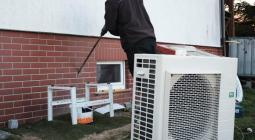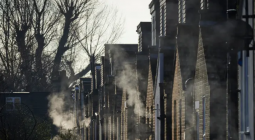The truth about heat pumps and the power needed to run them

The way we heat our homes is changing.
As the world moves away from fossil fuels, we will be saying goodbye to our gas fires and boilers - and instead electrifying the heating systems in our homes.
Extinguishing the fires in our homes is a big change, human beings evolved around the comfort of a campfire.
So, what will this mean for you - and the systems that deliver the energy we depend upon?
In just 12 years' time you won't be able to buy a gas boiler any more.
The government has ordered that sales of new ones will be banned from 2035.
Heating our homes accounts for as much as 16% of the UK's planet-warming carbon dioxide emissions.
In just 12 years' time you won't be able to buy a gas boiler any more.
The government has ordered that sales of new ones will be banned from 2035.
Heating our homes accounts for as much as 16% of the UK's planet-warming carbon dioxide emissions.
Sounds like a no-brainer, doesn't it?
Unfortunately, it is not quite as simple as that.
Heat pumps produce hot water at lower temperatures than gas boilers.
That means to get the heat into your home, it is a good idea to have bigger radiators.
And you will keep more of the heat in if your home is well-insulated and has double glazing. But doing that additional work can massively add to your costs.
Typically it costs £10,000 to buy and install a heat pump.
And there is another issue.
Unit for unit, electricity typically costs three times as much as gas.
That means even though your new heat pump is three times as efficient as your gas boiler it costs about the same to run.
Heat pumps: What they really mean for you
Investigating the controversial plans to change how we heat our homes and produce electricity. Is it possible and what will it take?
Watch now on BBC iPlayer (UK Only)
There's a £5,000 grant to help householders with the costs in England, Wales and Northern Ireland. Scotland is more generous, it offers £7,500.
But critics say that is not enough and that people need more help if the government is going to get anywhere near its target of 600,000 new heat pump installations every year by 2028.
At the moment it is way below that.
There were just 60,000 heat pumps installed in the UK last year, making it one of the slowest adopters of this new technology in Europe.
At current rates of installation, it will take more than 400 years before every British home has a heat pump.
So far fewer than 12,000 grants have been cashed - perhaps because it only covers the cost of the pump itself, and not the installation.
And even if households are able to pay, there is another barrier to hitting the government's heat pump targets.
The UK only has 4,000 trained heat-pump installers - it is estimated we will need 33,000 by 2028.
There are other electric heating systems - immersion boilers, electric fires, fan heaters and infra-red radiators, for example - but none of these is as efficient as heat pumps.
An alternative could be hydrogen-powered boilers.
They are just like your existing gas boiler - so no need for a new set of radiators - except that they burn hydrogen instead of natural gas.
But using hydrogen has its problems - for a start, where would it all come from?
Most of the readily available hydrogen is locked up in the water of our oceans.
The cleanest and greenest way to produce it would be to use electricity, through a process called electrolysis - but most of the time it would be more efficient just to use that electricity to heat our homes with heat pumps.
We could produce hydrogen from the natural gas we currently use, but we would then have to find a way to stop all the carbon dioxide (CO2) the process produces from going into the atmosphere.
The CO2 could be captured and pumped underground - but that is expensive and has never been done at scale before.
What is more, hydrogen boilers have not proved popular with the public.
A trial scheme in Ellesmere Port has just been cancelled after residents refused to have new boilers installed in their homes.
Whatever choices we make about how we heat our homes in future one thing is certain, we are going to need a lot more electricity.
And it all needs to be green.
Right now, at peak times, the National Grid requires 60GW of electricity.
By 2050, some estimates suggest it will need to double to at least 120GW.
At the moment about 40% of our electricity is generated by burning gas - so that's going to have to be phased out.
In 27 years, we need to roughly quadruple the amount of green energy we produce as a country.
So, to get to net zero in time, the government has set an ambitious target - decarbonise the entire electricity supply by 2035.
The UK has been making great progress with offshore wind, but building wind turbines at sea is expensive.
The cheapest renewable power is from onshore wind and solar.
Many experts say the UK will need thousands of much cheaper wind turbines on land.
hat will require changes to the planning rules which currently make it very difficult to get approval - opponents say they blight the landscape and there are worries about the impact they have on birds and animals.
And the government says we need more nuclear power too, even though it is expensive and takes years to build.
Most of our existing nuclear plants are due to be shut down in the next few years but there are two big new plants in the offing.
Hinkley Point C in Somerset is massively over budget and is now expected to start operating in 2027.
A second new plant has been proposed in Suffolk, next to Sizewell B, but it has been stuck in planning.
And to get these new sources of electricity into your home the electricity grid needs a massive and expensive upgrade too.
But we can do it, says Emma Pinchbeck, the CEO of Energy UK which represents the power generating industry and the National Grid.
"In my job, what's changed over the last five years has been this is no longer about money. It's about wires in the ground or enough people to build the kit," she says.
We have got the technology to reach net zero, the question is whether we can put it in place fast enough to meet our 2050 target and avoid the worst impacts of climate change.

cover photo:Heated skirting boards and mirrors feature in the Energy House 2 at Salford University





